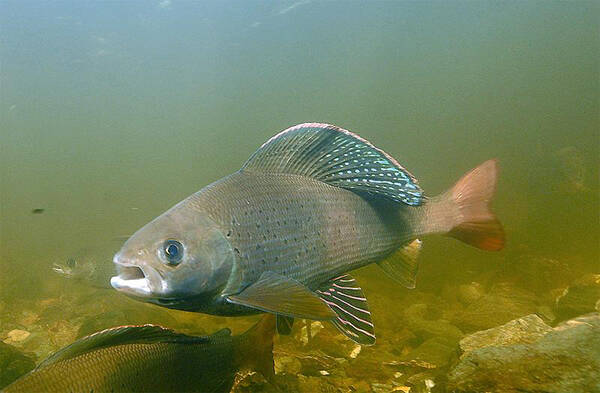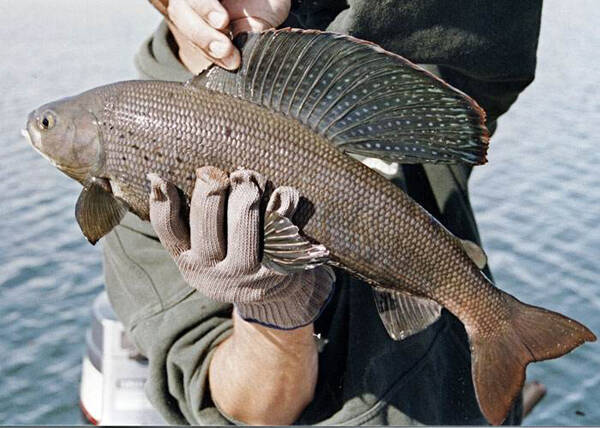Arctic grayling (scientific name: Thymallus arcticus): is an animal of the family Thymallus and genus Thymallus.

Arctic grayling may move tens of kilometers seasonally or annually between spawning, feeding, and sheltering habitats. Some Arctic grayling are known to travel more than 160 kilometers in a year. Many of the behaviors of Arctic graylings revolve around strategies to help survive in the harsh, uncertain environment of the Arctic. One strategy is to migrate for food and spawning. Individuals may use different streams for spawning, development, overwintering, and summer feeding, although some individuals spend their entire lives in one area of a stream or lake. They are active during the day.
There are no studies on communication and perception in Arctic graylings, but it is assumed that they have sensory perception similar to other freshwater fish, including chemoreception and the lateral line system. One form of perception is through chemoreceptors, which respond to chemical stimuli in the water and produce taste and smell. Another form of perception is the lateral line system. This system is common in fish and detects the movement of other fish and prey through changes in electrical currents and vibrations caused by other organisms. They are visual predators, responding to visual cues to detect and attack prey.
Arctic graylings include several ecotypes (lakes, riverine lakes, rivers, streams), which differ in migration patterns and duration of different stages of the life cycle. Lifespan is up to 10 years. First spawning occurs in 3-4 years, and the short-cycle ecotype in streams is 1-2 years. Breeding males are brighter in color and have a larger back. In April-May, they migrate upstream to feed and lay eggs; in summer, they return to larger streams and lakes downstream, and then in winter, they migrate to deeper places. Spawning occurs in May-June at 6-12°C. Embryonic development takes 10-14 days.
Arctic graylings feed on benthic organisms, small fish, algae and plants. During the short boreal summer, Arctic grayling feed on floating aquatic insects such as blackflies (Symphidae), mayflies (Ephemeroptera), stoneflies (Orthoptera), and caddisflies (Trichoptera). Sometimes, Arctic grayling will take eggs of spawning salmon, small fish, or terrestrial insects that have fallen into the water. They may even eat an occasional vole, lemming, or shrew. Young Arctic grayling feed on zooplankton, eventually transitioning to insect larvae. Hatchlings and small larvae feed on small crustaceans and other small objects, and then up to 70% of their diet consists of insect larvae, worms, mollusks, and terrestrial insects.

As spring approaches, Arctic graylings flock upstream to spawning areas. They are oviparous, like most other fish, and they begin spawning in the spring, when the ice begins to break up. Depending on the size of the female, 1,500-30,000 eggs are laid, each about 2.5 mm in diameter. The eggs sink to the bottom of the riverbed and get stuck between pebbles and gravel. Only about 10% of the fry that hatch from the eggs will grow up and be able to lay eggs.
Arctic grayling spawn in the spring, with eggs laid in shallow waters of rivers with moderate currents and in gravel or rocky areas of a substrate composed of fine sand sediments. Spawning in lakes is rare. Arctic char have modified their behavior to give them better spawning and reproduction capabilities. During the mating season, males defend their spawning areas for up to 7 days against other males. Females do not display agitated behavior during this season. During mating, other males will try to beat other males from future mates. Females can also swim past. Males court females by flashing their colorful dorsal fins. These fins are also used to support receptive females to aid in the mating process. Although they do not dig red nest holes in the substrate, mating behavior triggers large amounts of substrate that serve as a kind of nest for the eggs. The roe (eggs) remain on the bottom of the riverbed, mixing with the seminal fluid (sperm) released by the male. The female leaves and seeks another future male to mate with, leaving the fertilized eggs covered with substrate and left to fend for themselves. However, less than 50% of spawning attempts actually complete fertilization due to interference from other fish or the female moving away from the male. Arctic char are promiscuous, with males mating multiple times with several females and females mating more than once with several males.
Arctic grayling fry hatch 2-3 weeks after spawning and are about 1.3 cm long when they hatch. The fry immediately swim toward calm, warm shoreline waters, where they will grow to 5-10 cm by the end of summer. The fry are miniature versions of the adult fish. They continue to grow rapidly and mature in 3-4 years. They then devote more of their intake energy to spawning work, and their growth rate begins to slow. In many streams and lakes, the species has the fastest growth rate of any Arctic fish. Embryos and juveniles of the Arctic grayling are exposed to increasingly cold temperatures as they develop. During these life stages, the fish are exposed to microbial bacterial pathogens that are often temperature- and sex-specific and result in behavioral and immune responses. While this does not directly affect the sex determination of an individual, studies have shown that males appear to have sex-specific behaviors or tolerance to warm temperatures that females do not have.
The lifespan of the Arctic grayling is typically about 18 years. However, individuals in Alaska have been known to live up to 32 years. Most mortalities occur among eggs, larvae, and fingerlings or in areas where these fish are heavily fished.
While the Arctic grayling are not considered an endangered species, they are sensitive to pollution in the areas where they live, which can lead to local extinctions. They are most vulnerable to overfishing, competition, road culverts, mining, agriculture, and destructive forestry practices. A 2013 survey indicated that the population of the subspecies North American grayling has been declining steadily, and the species is listed as a candidate for "species of concern" and may require protection under the Endangered Species Act.
Listed in the IUCN Red List of Threatened Species 2008 ver3.1 - Least Concern (LC).
Listed in Appendix I, II and III of the Convention on International Trade in Endangered Species of Wild Fauna and Flora (CITES) 2019 Edition Appendix II.
Listed in China's National Key Protected Wildlife List (February 5, 2021) Level II.
Protect wild animals and stop eating game.
Maintaining ecological balance is everyone's responsibility!